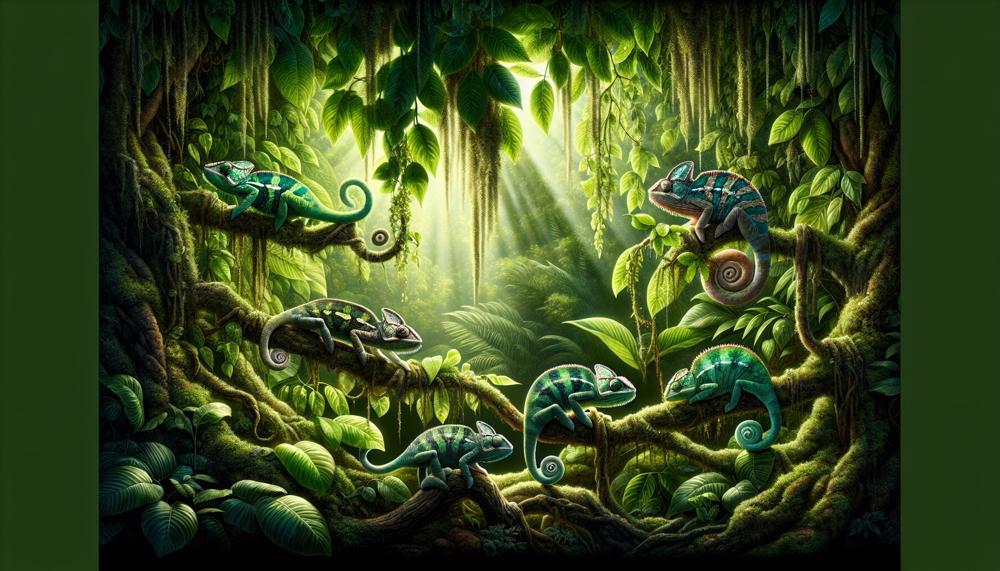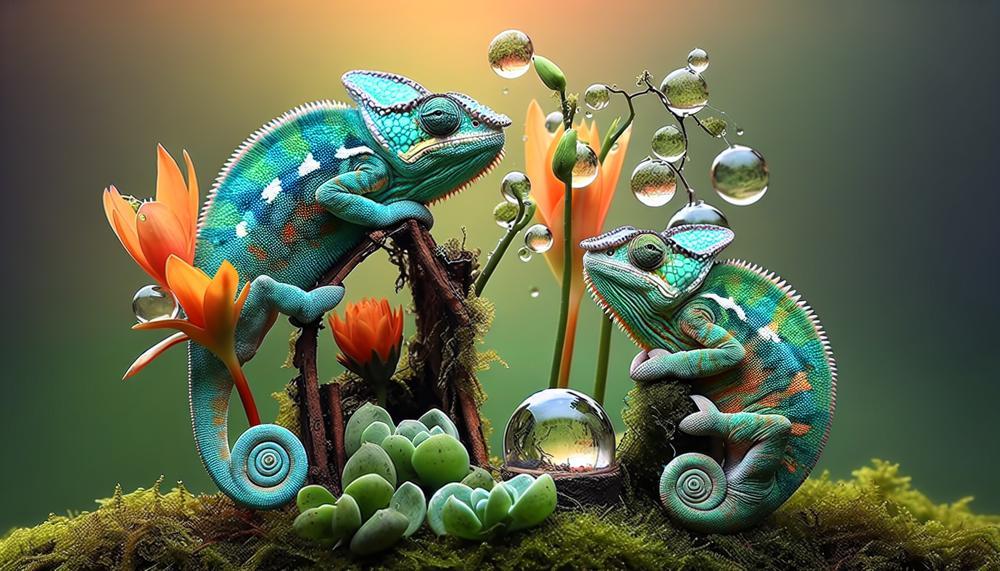The Chameleons are renowned for their remarkable ability to blend seamlessly into their surroundings, but have you ever wondered where they actually reside? In this article, we will embark on a journey through the diverse and dynamic environments that chameleons call home.
From lush rainforests to harsh deserts, these adaptable reptiles have evolved to thrive in a variety of conditions.
Prepare to be enthralled as we uncover the secrets of their unique habitats and how they have adapted to survive in each one. Here are some key points we will explore:
- The different chameleon species found across the globe
- How their habitats influence their physical appearance and behavior
- The crucial role of camouflage in their survival
- Fascinating adaptations for extreme climates
- Ongoing threats to chameleon habitats and conservation efforts
So, grab your binoculars and join us on this expedition through the ever-changing homes of chameleons. Let’s dive in.
Contents
- 1 Where Do Chameleons Live?
- 2 Tropical Rainforests: A Home for Color-Changing Creatures
- 3 Surviving in the Desert: Chameleons’ Adaptations and Diet
- 4 Savannas: Where Open Spaces and Foliage Meet
- 5 Mountains: High Altitudes for Specialized Chameleons
- 6 Island Endemics: Unique Habitats for Rare Species
- 7 Threats to Chameleon Habitats and Conservation Efforts
- 8 Conclusion
Where Do Chameleons Live?
Chameleons are known for their remarkable ability to adapt to various environments, ranging from rainforests and deserts to savannas and mountains. They can even be found on isolated islands, showcasing their incredible adaptability. These diverse habitats provide chameleons with the essential resources they need for survival, such as food, shelter, and temperature regulation.
Due to their arboreal nature and impressive camouflage abilities, chameleons are well-suited for life in trees and shrubs, which are abundantly found in these environments.
One of the most fascinating aspects of chameleons is their ability to evolve and thrive in different conditions. Each environment has its unique challenges, yet these creatures have evolved to adapt and overcome them. It’s a testament to their impressive survival skills and their ability to thrive in diverse habitats.
For example, chameleons living in the rainforest have adapted to the humid and warm climate, while those in the desert have evolved to conserve water and withstand extreme temperatures. In comparison, chameleons in mountainous regions have adapted to colder temperatures and steep terrain.
Their unique abilities extend beyond physical adaptations.
Chameleons also display remarkable behavioral patterns that help them survive in their respective environments.
In the rainforest, they use their long tongues to capture prey, while those living in deserts use their color-changing abilities to regulate body temperature.
Tropical Rainforests: A Home for Color-Changing Creatures
In the lush and diverse tropical rainforests, chameleons utilize their unique color-changing abilities in a multitude of ways to survive. Let’s delve into some of these strategies below.
Camouflaging with their surroundings
One of the primary uses of chameleons’ color-changing abilities is for camouflage. The tropical rainforest is teeming with a vast array of colors and patterns, making it the perfect environment for chameleons to blend in. By altering their skin color and patterns, they can easily conceal themselves from predators and stealthily approach their prey.
Attracting potential mates
Another way chameleons employ their color-changing abilities is to attract potential mates. Male chameleons often display vibrant and eye-catching colors while trying to impress a female.
They can swiftly change their colors to dazzle the female and establish dominance over rival males.
Thermoregulation
The tropical rainforest can be a hot and humid environment, so chameleons also use their color-changing abilities to regulate their body temperature.
By changing their skin color, they can absorb or reflect sunlight and heat as needed, maintaining an optimal body temperature.
Intimidating predators
In addition to camouflaging, some chameleons use their color-changing abilities to intimidate predators.
When threatened, they may alter their skin color to appear larger or more aggressive, warding off potential attackers.
Reflecting light
Lastly, chameleons utilize their color-changing abilities to reflect light.
This helps them blend in with their surroundings by mimicking the light patterns in the forest, allowing them to become nearly invisible to predators.
Surviving in the Desert: Chameleons’ Adaptations and Diet
Chameleons are intriguing creatures that have evolved unique adaptations to survive in the harsh environments of the desert. These adaptations not only help them survive, but also allow them to thrive in conditions that would be challenging for most other animals.
Here, we will explore how chameleons’ remarkable adaptations enable them to survive in the desert, and the vital role their diet plays in this process.
Adaptations for Survival:
Chameleons have several physical adaptations that enable them to thrive in the desert. Their most well-known adaptation is their ability to change skin color.
While chameleons in tropical rainforests use this ability for camouflage, desert-dwelling chameleons use it to regulate their body temperature.
By changing their color to a lighter shade, they can reflect more light and stay cool in the scorching desert sun.
Another physical adaptation that aids chameleons’ survival in the desert is their 360-degree vision. This remarkable vision allows them to see all around them without any blind spots, making it easier for them to spot predators and hunt for food.
Some species of chameleons also have a hood that acts as a water collection tool, allowing them to drink water droplets from plants or rocks.
Their slow and deliberate movements are also an essential adaptation for surviving in the desert. Chameleons move slowly to conserve energy and avoid detection by predators.
This also aids them in catching prey more efficiently as they can make precise movements when hunting insects.
Dietary Needs:
Chameleons have specific dietary needs that must be met for them to survive in the harsh desert environment.
Their diet mainly consists of insects such as crickets, grasshoppers, and locusts. These insects provide chameleons with vital nutrients such as protein, calcium, and vitamins.
As desert-dwelling animals, chameleons also need to stay hydrated.
They get most of their water from the insects they eat, but they also drink water droplets from plants and rocks. This is where their hood comes in handy, as it can collect and store water for them to drink.
Savannas: Where Open Spaces and Foliage Meet
Chameleons have undergone remarkable evolution and developed unique adaptations to thrive in the vast savannas, where open spaces and foliage collide. These adaptations are essential for their survival as they navigate through a diverse landscape filled with predators and ever-changing environmental conditions.
- Color-changing abilities: One of the most intriguing and well-known adaptations of chameleons is their ability to change the color of their skin. They possess specialized skin cells that contain pigments and crystals, which they can manipulate to produce various hues. This allows them to blend seamlessly into their surroundings, avoiding detection by predators and attracting potential mates.
- 360-degree vision: Chameleons have eyes that can move independently, giving them a full 360-degree view of their surroundings without any blind spots. This exceptional vision allows them to spot potential threats and prey from all directions, ensuring their survival in the savanna environment.
- Precise body movements: These slow-moving creatures possess remarkable control over their body movements, enabling them to hide from predators by mimicking the swaying of leaves or branches. Furthermore, they use these precise movements to communicate with other chameleons through visual signals, ensuring efficient communication within their community.
- Specialized feet: The feet of chameleons are another unique adaptation that enables them to thrive in the open spaces and foliage of savannas. Their horizontal toes allow them to grip onto branches with ease, preventing them from falling or being carried off by predators.
- Water collection: Some species of chameleon have developed a special hood on their heads that collects water from rain or dew. This adaptation serves a dual purpose, helping them stay hydrated in the dry savanna environment while also serving as a display to attract potential mates or intimidate rivals.
Mountains: High Altitudes for Specialized Chameleons
The towering peaks of mountains are known for their harsh conditions and high altitudes, making them a challenging environment for most animals. However, chameleons have managed to adapt and thrive in these areas as well.
Their unique abilities and adaptations have allowed them to survive and thrive in the challenging mountain environment.
Color-changing abilities:
Chameleons’ renowned color-changing abilities not only help them blend in with their surroundings but also serve as a means of temperature regulation.
In the high altitudes of mountains, temperatures can fluctuate drastically, and chameleons use their color-changing abilities to absorb or reflect heat, allowing them to regulate their body temperature.
Unique foot shape:
Chameleons have specialized feet with two toes sticking out horizontally, giving them a strong grip on branches.

This adaptation helps them navigate steep and rocky terrain in the mountains, making it easier for them to move around and avoid predators.
Slow-moving and stillness:
In high altitudes, predators are always on the lookout for prey.
Chameleons have adapted to this by being slow-moving and capable of sitting perfectly still for extended periods. This allows them to hide from predators and avoid being detected.
360-degree vision:
One of the most remarkable adaptations of chameleons is their 360-degree vision, giving them a full view of their surroundings without any blind spots.
In high altitudes where predators can approach from any direction, this adaptation is crucial for survival.
Water collection hoods:
Water is scarce in high altitudes, making it challenging for animals to survive.
However, chameleons have a unique hood on their heads that helps them collect water from dew or mist. This adaptation allows them to stay hydrated and thrive in areas where water is scarce.
Island Endemics: Unique Habitats for Rare Species
Island habitats are incredibly special and play a vital role in the survival of rare species, such as chameleons.
These habitats offer a stable and specialized environment for these creatures to thrive, ensuring their conservation.
| Factors | Description |
| Isolation | Islands are separated from the mainland by vast bodies of water, making it challenging for species to migrate and colonize. This isolation leads to the evolution of distinct and specialized species found only on that particular island. |
| Lack of competition | Due to the limited space and resources on islands, there is less competition among various species for food and shelter. This allows rare species like chameleons to have a better chance at survival. |
| Diverse microclimates | Islands offer unique microclimates within a small geographical area, resulting in diverse habitats for different species. This diversity allows chameleons to adapt to a range of environmental conditions within one island. |
| Lower rates of extinction | Island species have evolved to be resilient and have fewer predators due to their isolation and lack of human interference. This results in a more stable environment for rare species like chameleons. |
Threats to Chameleon Habitats and Conservation Efforts

Chameleons are facing an array of threats to their habitats, including deforestation, over-collection for the pet trade, pesticide use, and climate change. These detrimental factors have resulted in a decline in chameleon populations and put many species at risk of extinction.
In response to these threats, several conservation efforts have been implemented to safeguard chameleon habitats. These initiatives include:
- Preserved Areas: Many countries have designated protected areas specifically for the conservation of chameleons and other vulnerable species. These areas serve as sanctuaries for chameleons to flourish without the fear of habitat destruction.
- Reforestation: Deforestation is one of the primary threats to chameleon habitats. However, reforestation efforts can help restore their natural habitat and provide essential food sources for these creatures.
- Sustainable Harvesting: To mitigate the impact of over-collection on chameleon populations, conservation organizations advocate for sustainable harvesting practices and collaborate with local communities to find alternative livelihoods.
- Education and Awareness: Educating local communities about the significance of chameleon habitats and the threats they face is critical in promoting conservation efforts. This includes teaching sustainable practices such as responsible pesticide use and discouraging illegal wildlife trade.
- Rescue and Rehabilitation Programs: For injured or displaced chameleons due to human activities, rescue and rehabilitation programs offer a safe environment for recovery and eventual release back into the wild.
Conclusion
In conclusion, chameleons are truly extraordinary creatures, capable of thriving in a wide range of environments.
From the vibrant rainforests to the harsh deserts and even isolated islands, these adaptable creatures have found ways to survive and thrive. Their unique abilities and physical adaptations allow them to blend in seamlessly with their surroundings, making them masters of camouflage.
However, their habitats are facing numerous threats such as deforestation and over-collection for the pet trade.
To protect these captivating creatures, conservation efforts such as preserved areas, reforestation, and education initiatives have been implemented.
It is crucial that we continue these efforts to safeguard chameleon habitats and ensure the survival of these enchanting creatures for future generations.






